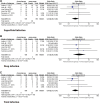Comparison of open and closed reduction and percutaneous pinning for pediatric lateral humeral condyle fractures: A systematic review and meta-analysis
- PMID: 40228269
- PMCID: PMC11999397
- DOI: 10.1097/MD.0000000000042060
Comparison of open and closed reduction and percutaneous pinning for pediatric lateral humeral condyle fractures: A systematic review and meta-analysis
Abstract
Background: Open reduction and percutaneous pinning (ORPP) is commonly regarded as the primary treatment option for serious displaced lateral condyle fractures of the humerus (LCFs) in children. However, some authors have suggested that closed reduction and percutaneous pinning (CRPP) may be an appropriate method for treating LCFs. This meta-analysis aims to compare the outcomes of these 2 fixation techniques.
Methods: Our study conducted a search of the Pubmed, Embase, and Cochrane Library databases for published research up to October 1, 2022. Our analysis comprehensively compared the operation failure rate, elbow function, and complication rate between CRPP and ORPP. This study was registered with PROSPERO (CRD42022379655).
Results: Our analysis included 6 non-randomized controlled trials and 532 patients. We used the Newcastle Ottawa Scale to assess the bias risk of these studies, with scores ranging from 6 to 9. The results indicate that both CRPP and ORPP yielded satisfactory elbow function outcomes (OR = 0.35, 95% CI = 0.07-1.88, P = .22). However, CRPP had a significant rate of operative failure (17.65%, OR = 21.77, 95% CI = 3.98-119.08, P = .0004) but a lower likelihood of unsightly scars (OR = 0.06, 95% CI = 0.01-0.31, P = .008). The failure rate of surgery is 0% in ORPP. There were no significant differences found in total infection (OR = 0.46, 95% CI = 0.21-1.01, P = .05), avascular necrosis (OR = 0.84, 95% CI = 0.09-7.79, P = .88), delayed union (OR = 1.49, 95% CI = 0.06-37.35, P = .81), or surgical time (MD = 4.46, 95% CI = -25.92 to 34.84, P = .77).
Conclusions: In comparison to ORPP, CRPP may result in a higher rate of operative failure but has been found to significantly reduce the occurrence of unsightly scars. Both CRPP and ORPP showed similar levels of postoperative functional satisfaction, with no statistical difference in other complications. Our research suggests that qualified closed reduction is a viable option for doctors to treat LCF.
Levels of evidence: IV.
Keywords: closed reduction and percutaneous pinning; lateral condyle fractures of humerus; meta-analysis; open reduction and percutaneous pinning.
Copyright © 2025 the Author(s). Published by Wolters Kluwer Health, Inc.
Conflict of interest statement
The authors have no conflicts of interest to disclose.
Figures
Similar articles
-
Comparison of outcomes of open reduction and internal fixation versus closed reduction and percutaneous pinning in Song type 4-5 pediatric lateral condyle fractures.Ulus Travma Acil Cerrahi Derg. 2024 Nov;30(11):821-827. doi: 10.14744/tjtes.2024.04561. Ulus Travma Acil Cerrahi Derg. 2024. PMID: 39498703 Free PMC article.
-
Clinical results of closed versus mini-open reduction with percutaneous pinning for supracondylar fractures of the humerus in children: A retrospective case-control study.Medicine (Baltimore). 2018 Nov;97(45):e13162. doi: 10.1097/MD.0000000000013162. Medicine (Baltimore). 2018. PMID: 30407346 Free PMC article.
-
Closed Reduction and Percutaneous Pinning Versus Open Reduction and Internal Fixation for Type II Lateral Condyle Humerus Fractures in Children Displaced >2 mm.J Pediatr Orthop. 2016 Dec;36(8):780-786. doi: 10.1097/BPO.0000000000000570. J Pediatr Orthop. 2016. PMID: 26090985
-
K-wire versus screws in the fixation of lateral condyle fracture of humerus in pediatrics: a systematic review and meta-analysis.BMC Musculoskelet Disord. 2023 Aug 12;24(1):649. doi: 10.1186/s12891-023-06780-5. BMC Musculoskelet Disord. 2023. PMID: 37573303 Free PMC article.
-
A meta-analysis of closed reduction percutaneous pinning and open reduction with pin fixation of pediatric humeral lateral condylar fracture.Front Pediatr. 2023 Jun 30;11:1205755. doi: 10.3389/fped.2023.1205755. eCollection 2023. Front Pediatr. 2023. PMID: 37456567 Free PMC article. Review.
References
-
- Abzug JM, Dua K, Kozin SH, Herman MJ. Current concepts in the treatment of lateral condyle fractures in children. J Am Acad Orthop Surg. 2020;28:e9–19. - PubMed
-
- Song KS, Waters PM. Lateral condylar humerus fractures: which ones should we fix? J Pediatr Orthop. 2012;32(Suppl 1):S5–9. - PubMed
-
- Beaty JH. Fractures of the lateral humeral condyle are the second most frequent elbow fracture in children. J Orthop Trauma. 2010;24:438. - PubMed
-
- Bhandari M, Tornetta P, Swiontkowksi MF; Evidence-Based Orthopaedic Trauma Working Group. Displaced lateral condyle fractures of the distal humerus. J Orthop Trauma. 2003;17:306–8. - PubMed
-
- Weiss JM, Graves S, Yang S, Mendelsohn E, Kay RM, Skaggs DL. A new classification system predictive of complications in surgically treated pediatric humeral lateral condyle fractures. J Pediatr Orthop. 2009;29:602–5. - PubMed
Publication types
MeSH terms
LinkOut - more resources
Full Text Sources
Medical
Research Materials





